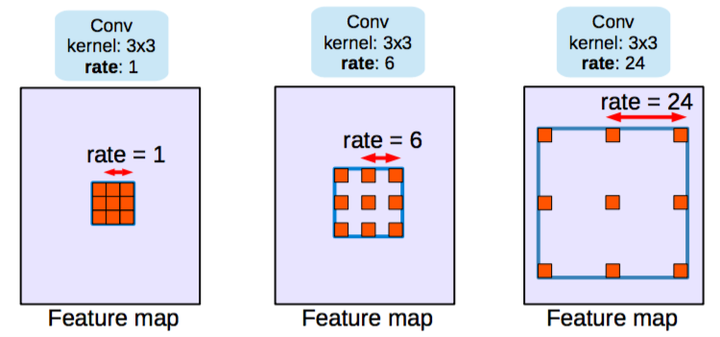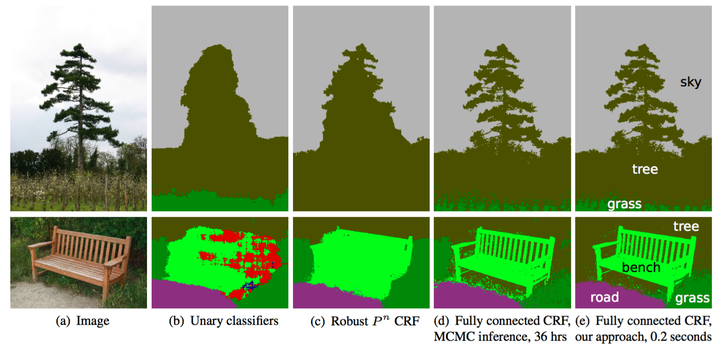## 把分类网络修改为语义分割的网络存在下面问题:
1. 分辨率变小(the reduction of signal
resolution incurred by the repeated combination of max-pooling and downsampling (‘striding’) performed at every layer of standard DCNNs)
2. spatial ‘insensitivity’ (invariance)。(relates to the fact that obtaining object-centric decisions from a classifier requires invariance to spatial transformations, inherently limiting the spatial accuracy of the DCNN
model)-- This is
due to the very invariance properties that make DCNNs good for high level tasks
*****
我们来看FCN怎么来解决这两个问题的?
### 第一个问题解决思路:
使用了称作空洞卷积的结构,且去除了池化层结构。

空洞卷积,当比率为1时,即为经典的卷积结构。池化操作增大了感受野,有助于实现分类网络。同时保证了分类的精度
因此,该论文所提出的空洞卷积层是如此工作的:

### 第二个问题解决思路:
**条件随机场(Conditional Random Field,CRF)方法通常在后期处理中用于改进分割效果**。CRF方法是一种基于底层图像像素强度进行“平滑”分割的图模型,在运行时会将像素强度相似的点标记为同一类别。加入条件随机场方法可以提高1~2%的最终评分值。

发展中的CRF方法效果。b图中将一维分类器作为CRF方法的分割输入;c、d、e图为CRF方法的三种变体;e图为广泛使用的一种CRF结构。
### DeepLab总览:
**DeepLab(v1和v2)**
论文1:
Semantic Image Segmentation with Deep Convolutional Nets and Fully Connected CRFs
于2014年12月22日提交到Arvix
[https://arxiv.org/abs/1412.7062](http://link.zhihu.com/?target=https%3A//arxiv.org/abs/1412.7062)
论文2:
DeepLab: Semantic Image Segmentation with Deep Convolutional Nets, Atrous Convolution, and Fully Connected CRFs
于2016年6月2日提交到Arxiv
[https://arxiv.org/abs/1606.00915](http://link.zhihu.com/?target=https%3A//arxiv.org/abs/1606.00915)
主要贡献:
* 使用了空洞卷积;
* 提出了在空间维度上实现金字塔型的空洞池化atrous spatial pyramid pooling(ASPP);
* 使用了全连接条件随机场。
具体解释:
空洞卷积在不增加参数数量的情况下增大了感受野,按照上文提到的空洞卷积论文的做法,可以改善分割网络。
我们可以通过将原始图像的多个重新缩放版本传递到CNN网络的并行分支(即图像金字塔)中,或是可使用不同采样率(ASPP)的多个并行空洞卷积层,这两种方法均可实现多尺度处理。
我们也可通过全连接条件随机场实现结构化预测,需将条件随机场的训练和微调单独作为一个后期处理步骤。
- 序言
- 第一章 机器学习概述
- 第二章 机器学习环境搭建
- 环境搭建
- 第三章 机器学习之基础算法
- 第一节:基础知识
- 第二节:k近邻算法
- 第三节:决策树算法
- 第四节:朴素贝叶斯
- 第五节:逻辑斯蒂回归
- 第六节:支持向量机
- 第四章 机器学习之深度学习算法
- 第一节: CNN
- 4.1.1 CNN介绍
- 4.1.2 CNN反向传播
- 4.1.3 DNN实例
- 4.1.4 CNN实例
- 第五章 机器学习论文与实践
- 第一节: 语义分割
- 5.1 FCN
- 5.1.1 FCN--------实现FCN16S
- 5.1.2 FCN--------优化FCN16S
- 5.2 DeepLab
- 5.2.1 DeepLabv2
- 第六章 机器学习在实际项目中的应用
